
Certainly, if you live in the southern states, you know what Okra is. If you’re a southern gardener, you’re growing okra in your garden, too. But, if you live in northern or western areas of the United States, you might have no idea what it is. Can you believe it!? It’s a fact. Therefore, we challenge all gardeners who have never grown it, to learn how to grow okra. Then, grow it this year in your vegetable garden. You’ll be glad that you did.
Here’s another amazing fact: even a lot of people who know what it is, say they have never eaten it. At least they do not think they have. However, if you have ever had a gumbo recipe of any kind, you have eaten it. Also, if you’ve eaten any southern cooking, you’ve likely had Okra.
The part of the plant that you eat, is actually the seed pod.
Okra is grown all over the world. It is most common in the southern part of the U.S., and uncommon elsewhere. Now here comes the good part….. Growing it is easy. And, it grows quickly. Its quick maturation makes it a vegetable that can be grown even in areas with short seasons. So, if you have not tried it in your garden before, give it a try this year.
Did You Know? Okra is related to Hibiscus.

Common varieties include:
Clemson Spineless
Dwarf Long Pod Green
Red Burgundy

Sow Okra seeds 1/2 inch or less deep. Space seeds 6 to 8 inches apart, in rows 2 feet apart. A week or so after germination, thin plants to a final spacing of 12 to 18 inches apart.
Sow seeds early, after all, danger of frost has passed, and the weather has warmed. Do not rush to plant them after the last frost. The seeds prefer warm weather and need warm soil to germinate. The plants grow quickly in warm weather.

The plants are quick-growing in hot weather. It loves the heat more than perhaps most other vegetables. So, wait to plant okra seeds until just before hot weather sets in.
Garden Tip: As you harvest your cool weather lettuce greens, use the open space to plant okra.
Provide full sun and rich, well-drained soil.
Keep the plants watered, but make sure to provide good drainage, as they do not like to keep their feet wet for extended periods.
Apply fertilizer at planting time, and again three weeks later. Add mulch to keep weds down and to retain soil moisture.
Ideal Soil pH: 6.5 – 7.0
Also, see:
Soil Temperatures – Ideal germination temperature by vegetable
Ideal Soil pH – for all vegetables.
Aphids and other insects enjoy sucking on the juices of the plants. The first time this author ever grew it, the Okra mainly fed the insects. Insect control is important for a bountiful harvest.

Days to harvest: 50 – 60 days.
Harvest the pods are 3 – 4 inches long, while they are young and tender.
Okra pods will get hard and stringy quickly. Pick the pods regularly, as often as every other day. This encourages the plant to produce more flowers and pods for an extended period of time.
Commonly grown in the south, Okra is susceptible to frost. Pod production diminishes in cool weather.
Looking for Okra recipes? May we suggest:
©1999-2024 GardenersNet.Com, All Rights Reserved